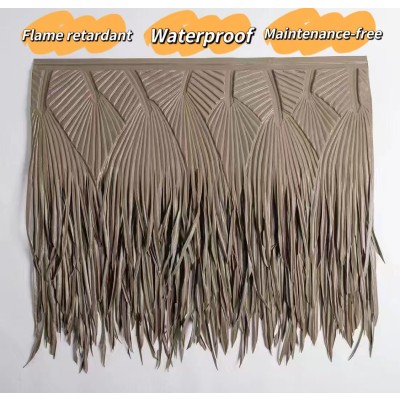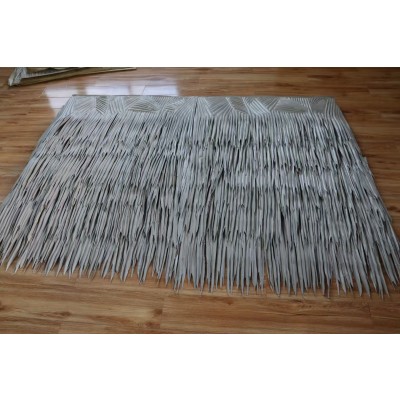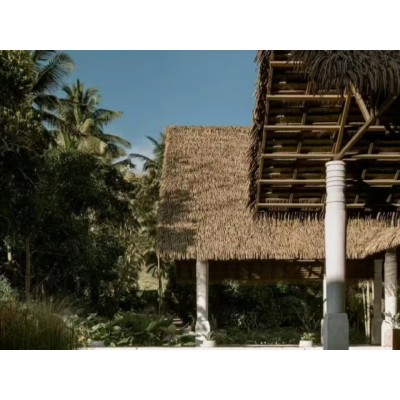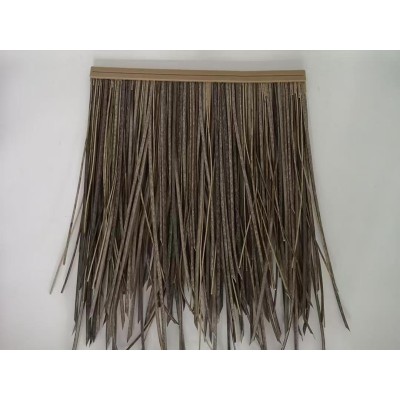Abstract: This paper focuses on the application of synthetic Palp Tiki thatch in tropical areas, and discusses its characteristics, advantages and applications in different scenarios. Through the analysis of relevant data and practical cases, the adaptability and development potential of the material in tropical areas were evaluated, which provided a theoretical basis for further popularization of the material in tropical areas.
Key words: synthetic; Palp Tiki thatch; The tropics; Apply
I. Introduction
(1) Research background
Because of its unique climatic conditions, the tropical region has a special demand for building materials and decorative materials. Although traditional thatch has some application in tropical areas, it has many limitations. As a new material, synthetic Palp Tiki thatch has gradually entered people's field of view, and its application in tropical areas has important practical significance.
(2) Research purpose and significance
The purpose of this study is to deeply understand the application of synthetic Palp Tiki thatch in tropical areas, explore its potential advantages and disadvantages, and provide more suitable material selection suggestions for architecture, landscape and other fields in tropical areas, so as to promote the development of related industries in this region.
Second, synthetic Palp Tiki thatch overview
(1) Material composition and characteristics
Main component
The basic materials of synthetic Palp Tiki thatch, such as [specific component 1], [specific component 2], etc., are introduced, and the effects of each component on material properties are expounded.
Physical characteristics
It includes the color, texture, flexibility, etc., and analyzes how these characteristics affect its appearance and practical use in tropical regions.
Chemical characteristic
The chemical corrosion resistance and stability of the material were discussed, and the chemical stability of the material in the environment of high humidity and strong ultraviolet light was explained.
(2) Production technology
The production process of synthetic Palp Tiki thatch was briefly described, such as [step 1], [step 2], etc. The influence of production process on material quality and properties was analyzed.
Third, the environmental characteristics of tropical areas and the requirements for materials
(1) Climate characteristics
Temperature and humidity
Tropical areas are always high temperature and high humidity, which is easy to lead to problems such as aging, deformation and mold of materials.
Light and rainfall
Strong ultraviolet radiation and frequent rainfall put forward higher requirements for the weatherability and waterproofing of materials.
(2) Cultural and architectural needs
Cultural tradition
Many parts of the tropics have a unique thatch architecture culture, with specific aesthetic needs for the appearance and texture of thatch materials.
Architectural function
Tropical architecture focuses on ventilation, shading, heat insulation and other functions, and requires materials that can assist in achieving these architectural goals.
Fourth, the application advantages of synthetic Palp Tiki thatch in tropical areas
(1) Durability
Aging resistance
Compared with traditional thatch, synthetic Palp Tiki thatch has better anti-aging properties and can be used for a long time in harsh tropical climate conditions without fading and deformation.
Corrosion resistance
The ability to resist chemical and biological corrosion common in tropical areas, such as resistance to mold, termites and so on, was analyzed.
(2) Maintenance costs
Low maintenance requirements
Synthetic Palp Tiki thatch does not need to be replaced and repaired as frequently as traditional thatch, reducing long-term costs.
Cleaning convenience
Describe the convenience of cleaning, such as a simple rinse can keep the appearance clean.
(3) Adaptability
Building adaptability
It can adapt to a variety of tropical architectural styles, whether it is a traditional thatched house or a modern architectural decoration, it can show a unique effect.
Environmental adaptability
In high temperature, high humidity, strong ultraviolet and other tropical environment, it can still maintain good performance.
5. Application scenarios of synthetic Palp Tiki thatch in tropical areas
(1) Construction field
Residential building
This paper introduces its application cases in roof and exterior wall decoration of residential buildings in tropical areas, and analyzes its effect on improving the aesthetics and functionality of residential buildings.
Public building
Explore the application in public buildings such as hotels, resorts and tourist attractions, such as creating a characteristic tropical architectural appearance to attract tourists.
(2) Landscape field
Theme park
In theme parks in tropical areas, synthetic Palp Tiki thatch can be used to create a unique landscape atmosphere, such as simulating tropical primitive jungle scenes.
Garden landscape
In the urban garden landscape, as a decorative material of characteristic landscape pieces, increase the tropical regional cultural characteristics of the garden.
6. Problems and challenges in the application
(1) Cost problem
Initial cost
The relatively high initial procurement cost of synthetic Palp Tiki thatch may limit its use in some cost-sensitive projects.
Cost-benefit analysis
Although long-term maintenance costs are low, in-depth cost-effectiveness analysis is required to determine economic viability at different project sizes and life cycles.
(2) Cognition and promotion
Market awareness
The current market awareness of synthetic Palp Tiki thatch is low, and many designers, builders and consumers do not know enough about its properties and how it can be applied.
Promotion difficulty
This paper analyzes the marketing difficulties facing the promotion of the material in tropical areas, such as the influence of traditional concepts and the impact of competitive materials.
Vii. Solution strategy and development prospect
(1) Solution strategy
Cost control
The ways to reduce the cost by optimizing the production process and expanding the production scale are discussed.
Marketing promotion
Propose strategies to enhance marketing promotion, such as holding product exhibitions, conducting publicity and education activities, etc., to improve product awareness.
2. Development prospects
Market potential
With the economic development and the prosperity of tourism in tropical areas, the demand for characteristic building and landscape materials is increasing, and synthetic Palp Tiki thatch has a broad market development space.
Technological innovation and application expansion
With the continuous progress of technology, synthetic Palp Tiki thatch is expected to further improve its performance, and its application fields will continue to expand.
Viii. Conclusion
(1) Research summary
The application advantages, application scenarios, problems and challenges of synthetic Palp Tiki thatch in tropical areas were summarized.
(2) Research prospects
The future development of synthetic Palp Tiki thatch in tropical areas is prospected, and the necessity of further research and promotion is emphasized in order to give full play to its application potential in the field of architecture and landscape in tropical areas.



